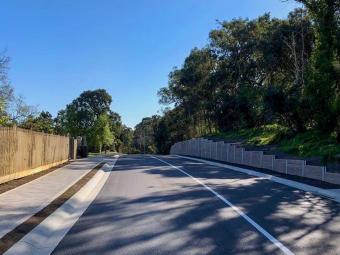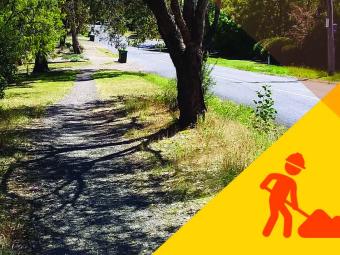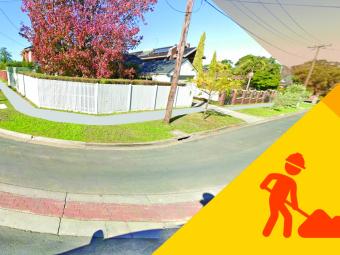Lost or stolen parking permits
If you have lost or had your permit stolen (except the accessible parking permit), you can apply for a new one online.
Applications are now open
We recognise the value of helping property owners to protect and manage significant:
- homes
- buildings
- trees
- gardens.
Appreciating the importance of our significant areas of interest, restoration incentives are provided under the following two categories:
- Buildings and Works
- Trees and Gardens
What the funds cover
The Heritage Restoration Fund (Buildings) provides owners of identified heritage properties to apply for a small grant. This will help with the maintenance and restoration of significant buildings and other places of interest.
The Heritage Restoration Fund (Trees and Gardens) provides owners of significant trees and gardens with help either to:
- undertake appropriate maintenance works
- obtain a suitable water supply to provide for the longevity of these trees and gardens.
Amount of funding available
A total of $35,000 is available across these two funding categories. We’ll generally provide funding for approved work on a dollar-for-dollar basis, up to a maximum amount of $3,000.
Properties eligible for funding assistance
Most owners of properties in the Heritage Overlay and the Vegetation Protection Overlay (Schedule 5) will be eligible to apply for funding through the appropriate Heritage Restoration Fund.
To find out more about the eligibility criteria and assessment priorities, download the policy below.
How to apply
If you’re ready to apply for funding, download the application form below.
In your application, include a copy of quotes for the restoration project, showing the value of the works. Also, provide photographs of the building, tree or garden in its current condition.
Making a claim if you’re successful
If you’re a successful applicant, complete the form below and send it to manningham@manningham.vic.gov.au.
You must also include receipts and photos showing the completion of works with your claim form.
Need help? Contact us.
Below we have collated some of our popular applications.
On this page
Can't find what you're looking for?
If you are experiencing genuine financial hardship you can apply for a special payment arrangement with us for your Rates.
How can I apply?
- Online – Complete an online application form and submit your supporting documentation.
- Mail – If you do not have access to a computer please phone us and we will mail out an application form to you. Once complete, please post the completed form, along with supporting documentation to Manningham Council, PO Box 1, Doncaster VIC 3108.
What do I need to apply?
You’ll need information about:
- Your property ID (can be found on your Rate/Instalment Notice)
- Your fortnightly income and expenses
- Your total assets and liabilities
- Reason for hardship
How long will you take to process my application?
Once received we will review your application within ten business days.
We are here to help If you have any questions or need assistance completing this application please contact us.
- Phone: 9840 9333
- Email: manningham@manningham.vic.gov.au
What is an accessible parking permit?
Formerly called a disabled parking permit, an Accessible Parking Permit (APP) is for drivers or passengers with a disability. It's also for organisations helping transport people with disabilities.
The Victorian Government introduced the Accessible Parking Permit Scheme to help make a simpler and more consistent process.
All councils across the state will use the same application process. This aligns with the Australian Disability Parking Permit Scheme.
What improvements have been made to the process?
-
temporary permits will be available for six, 12 or 24 month periods
-
permanent permits will be valid for five years rather than three years
-
the introduction of a permanent disability classification, so functional assessments aren’t required for future permit renewals
-
a single and secure state wide permit design that will reduce permit misuse
-
the inclusion of occupational therapists as assessors and GPs
-
permits for organisations will continue to be available for 12 month period.
Which types of permits can you apply for?
There are two types of permits available:
-
Australian disability parking permit (ADP) - allows you to park in:
-
an accessible parking bay for the specified time limit.
-
a standard parking bay for twice the time limit specified.
-
-
Victorian double time accessible parking permit – allows you to park in:
-
a standard parking bay for twice the time limit specified.
-
A GP or occupational therapist functional assessment will decide on whether to issue a permit and the permit type.
How to apply or renew your accessible parking permit
For individuals
-
You will receive a reference number via SMS
If you don’t have access to a mobile phone or the internet, contact us.
-
Take your reference number to your GP or occupational therapist
-
Your GP or occupational therapist will complete a functional assessment and submit your application
-
We will review and confirm your application
-
If your application is successful, you will receive your permit in the mail.
For organisations
-
You will receive a reference number via SMS
If you don’t have access to a mobile phone or the internet, contact us.
-
We will review and confirm your application
-
If your application is successful, you will be advised when it is ready to be picked up from our civic centre.
When you collect your permit you need to bring the following supporting documentation:
-
Business registration(s)
-
Proof the vehicles are registered to your business.
-
How to replace a damaged, lost or stolen accessible parking permit
If your permit is lost, damaged or stolen, you can apply for a replacement online.
-
You will receive a replacement application reference number via SMS and email
-
We will review and confirm the application
-
If your application is successful, you can pick up your permit from our civic centre
When you collect your permit you need to bring the following supporting documentation:
-
the damaged permit (if replacing)
-
a statutory declaration for a lost permit
-
a statutory declaration or a police report for a stolen permit.
-
Need help?
What if you have an existing permit?
All existing permits that are not a part of the current Accessible Parking Permit scheme will remain valid until their expiry date or until 30 June 2023, whichever date occurs first.
Related links
You can use this permit to apply for:
- skip bins
- shipping containers
on council-owned land.
If the obstruction relates to building works, you may also need an asset protection permit.
How to apply
Download and complete the application form:
and then:
- email manningham@manningham.vic.gov.au or
- post to Approvals and Compliance Unit, Manningham Council, PO Box 1, Doncaster, Victoria 3108
You can request to install private memorial plaques in Council reserves when the plaque is associated with Council-approved park furniture or tree.
How to apply
Complete the online application or download and complete the Request for Memorial Plaque and Donation of Park Furniture or Tree.
Read the Memorial plaques and public donation of park furniture or trees policy before you apply.
What happens next?
- Once we have received your application we will contact you to advise if it has been approved. We will also need to approve the wording of the plaque.
- We will provide you with specifications for your plaque. The text should fit within the plaque dimensions (100mm x 50mm).
- If your application is approved you will be invoiced for the cost of the furniture or tree.
- We will place an order once we receive full payment from you. Orders cannot be placed without full payment.
- Furniture delivery and installation can take up to three months.
- Tree planting will be subject to availability and suitable seasonal conditions.
- The applicant is responsible for the purchase of the plaque and delivery to council.
How much does it cost?
The applicant is responsible for the cost and ordering of the approved plaque.
Prices include GST.
- Timber Park Seat $3,850
- Timber Picnic Table $6,380
- Tree $495
Apply online
Each year we offer a series of land management grants that support the preservation of Manningham’s natural bushland and the productivity of rural land.
These grants are designed to help property owners with:
- tree planting
- weed removal
- pest animal control.
Who can apply for a grant
To apply for assistance to preserve your bushland you must live in a designated zone, near a wildlife corridor or waterway, or have previously participated in this program. Read the land management grant criteria below for the full details.
How to apply for a grant
If you meet any of these criteria, complete the online form or download an application form.
Local Environment Assistance Fund (LEAF)
Depending on where your property is located, you may be eligible for a LEAF grant to match your spending dollar for dollar on approved works, up to a certain limit.
| LEAF Category | Eligibility criteria |
|---|---|
|
Category A Grants of up to $1000 are available to fund approved works. |
|
|
Category B Grants of up to $1000 are available to fund approved works. |
|
|
Category C Grants of up to $500 are available to fund approved works. |
|
Resourcing Extra Local Environmental Assistance Fund (RELEAF)
RELEAF grants offer extra financial assistance to landholders that have large areas of remnant vegetation and are looking to manage their properties for biodiversity improvement, protection and conservation.
Successful RELEAF grants recipients will receive two thirds of the total cost to conduct approved works, to a maximum of $4,000 (i.e. maximum rebate of $4,000 possible where total cost is $6,000).
Applications will be assessed on:
- biodiversity merit
- the size of the habitat zone, minimum 5,000m2 (0.5ha)
- the priority of the works
- the property owners ability to manage a habitat zone into the future, including a voluntary three year action plan agreement
- property eligibility.
Approved works for LEAF and RELEAF grants
Please see the list below for eligible works and their priority level. Applications will be assessed based on the priority of works.
High priority works include:
- integrated rabbit control that includes warren destruction
- integrated environmental weed control
- integrated pest animal control
- revegetation to an appropriate standard for:
- enhancing identified habitat corridors or significant locations
- enhancing identified strategic ‘gaps’ in corridors or other strategic locations
- conservation of threatened species
- preventing and/or rehabilitating soil erosion.
- fencing of core and buffer habitat, high priority revegetation, or waterways and dams to prevent stock access/grazing
- other ‘significant’ habitat improvements on a case by case basis including ecological burns
- wetland enhancement
- earthworks for erosion control/prevention
- works for threatened species conservation.
Other works include:
- integrated rabbit control including at least two of the following methods:
- baiting using a licensed contractor
- harbour reduction and warren collapse.
- fumigating:
- ferreting
- long-netting
- monitoring.
- seed collection, propagation, and/or planting of indigenous species
- pasture management improvements including:
- integrated weed management
- contour fencing
- fencing and revegetation of gullies and building stock crossings
- manure management including harrowing, collection and composting
- building of sacrifice yards
- reseeding with local native grass species
- management to enhance native pastures.
Pest animal control grants
If your property is not eligible for LEAF or RELEAF, you can still claim funding for fox, rabbit and deer control.
If you are working with a Rabbit Action Group, funding of up to $500 per annum is available on a dollar for dollar basis.
Each year, eligible residents can access grant support to help with the cost of deer control. The percentage rebate and maximum amount available each financial year will be provided to you on application.
This grant is available in addition to LEAF and RELEAF grants. The control must be carried out under the Wildlife Act 1975 and the LEAF checklist requirements.
You can apply online for a deer control grant or download and complete the Land Management Grants application form.
If you have any questions about the deer control grant, please get in touch with our Environment Team on 9840 9333, or at environment@manningham.vic.gov.au.
Related downloads
Subscribe to our Environment Newsletter
Keep up to date with our latest environment and sustainability events.
Find permits, services and guides relating to parking, roads and footpaths
Report an issue with a tree on public land
You can report a tree or tree branch that is obstructing the road, footpath or is in danger of falling or causing damage.

Apply for works, drainage and stormwater connection permit
You will need a Works and Drainage Permit (WDP) to undertake works that impact Manningham’s assets.

Report a blocked or damaged street drain
We are responsible for an extensive network of underground drains that prevent storm-water run-off from impacting property, footpaths and roads.
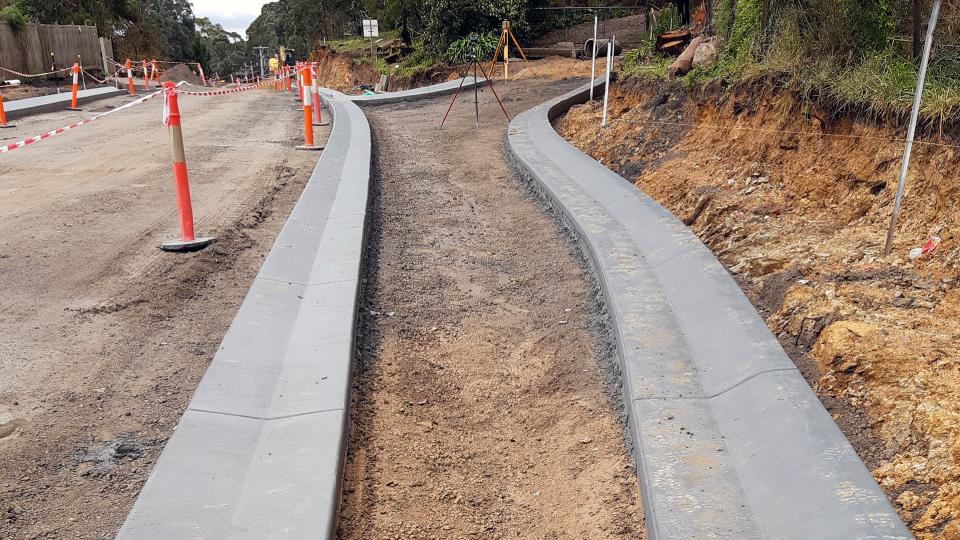
Drainage projects design and construction
Find out how we're improving drainage and flood mitigation.

Footpath maintenance and construction
Find out about new path projects in Manningham including footpaths, shared paths and shared trails.
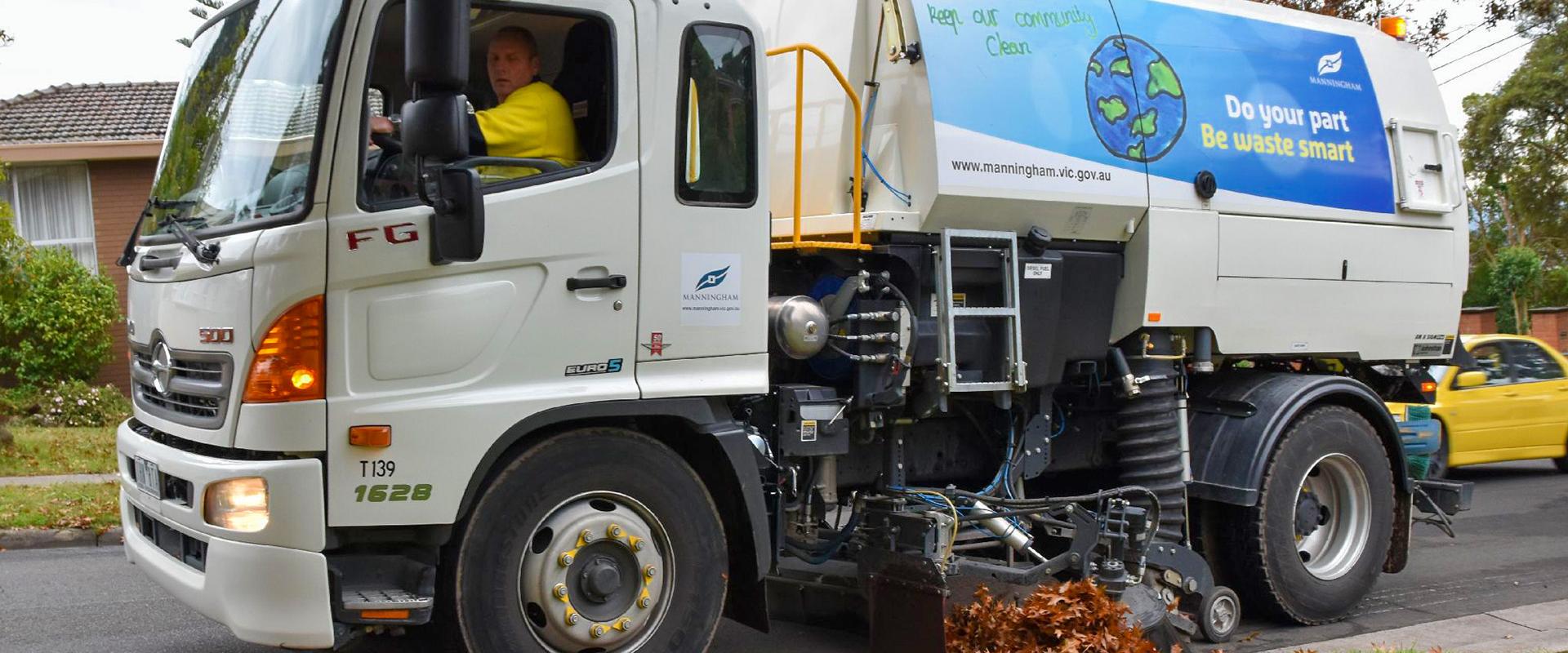
Street sweeping
We are responsible for maintaining 608km of local roads within Manningham. Find out more about our street sweeping program.
Can't find what you're looking for?
Shuttle Smash is an introductory program for children to experience badminton in a fun, inclusive environment.
The program teaches children badminton through the development of fundamental movement skills, including co-ordination, flexibility, strength, balance and fine motor skills.
Program information
- all equipment provided
- suitable for all genders
- this activity is for primary school children aged 5 - 12.
Terms and conditions
- Participants must be Manningham residents to qualify for the subsidized rate of $5
- Eligible families can apply for multiple children
- Participants can apply for multiple sessions.
How to apply
Register for individual sessions or all 4 days via FitForKidsco.
Select Manningham DISC in the drop down menu
Limited spots available - so book your spot now.
Here is a summary of the planning permit process.
1. Before you apply
-
New to planning? Get a general understanding of what permits you will need before making any applications
-
Get advice in writing about whether or not your proposed building, works or land use needs approval from us.
-
Get feedback on your draft proposals, concepts or plans, before you submit a formal planning permit application.
-
Check out some common scenarios and resources to help you understand what is needed before applying

2. Apply for the permit
Everything you need to know to start a planning permit application.
3. After we receive your application
-
Stay up to date with your application's status in the planning applications portal.
-
Find out what you need to do to amend your permit before the public notification stage.
4. Public notification of your application
-
Review all Applications currently undergoing assessment.
-
Any person who believes they will be affected by a planning application can lodge an objection during advertising.
-
Find out what you need to do to amend your permit before the decision stage.
5. We notify you of our decision once permit issued
-
Only the Victorian Civil and Administrative Tribunal (VCAT) can review an application. After we have made a planning permit decision, we cannot undertake an internal review.
-
Landscape bonds are a condition of a planning permit. We ask for payment of bonds to ensure landscaping works are properly completed.
-
If you need more time for development or commencement of land use, you will need to ask for an extension to the planning permit.
-
An Agreement under Section 173 of the Planning and Environment Act (or Section 173 Agreement) is a legal agreement between us and the owners of a property that is registered on a property title.
-
If you would like to to amend approved plans or conditions of a Planning Permit, you can find out more information and submit your application here.
-
If you are developing land in Manningham, you may need to submit a Construction Management Plan (CMP) as required by a condition of your planning permit.
6. Once your development is completed
-
If your Planning Permit required payment of a landscape bond, you will need to apply for a refund once your development is completed.
Change your contact details or withdraw your application
Follow these easy steps to change your planning application details:
- Search for your planning application on the planning applications portal.
- Select change applicant details or withdraw your application.
The Community Grant program supports and empowers community groups and organisations to deliver programs and activities for our community in Manningham.
We are committed to developing and fostering partnerships with not-for-profit groups and organisations whose work enriches the municipality and is consistent with our vision.
Grant opportunities
Funding opportunities

Apply for assistance to preserve your bushland
These grants are designed to help property owners with land care education, land stewardship, pest and animal control and ecological improvement works.
You may need to apply for a planning permit and application before you start a new development or commence a new land use. A planning permit gives you permission to use and/or develop land in a certain way when there’s a requirement for a permit. After granting a planning permit, you may also need other approvals from building, health, local laws and engineering.
We can fast track some applications. Check to see if your application is eligible for the VicSmart process.
Talk to us before you apply for a planning permit
You can organise a pre-application meeting. This gives planning officers the chance to provide feedback before you submit a formal planning permit application in relation to:
- draft proposals
- concepts
- plans.
You can organise a face-to-face meeting or receive a written response. This is an optional service and there will be a pre-application fee.
We can advise you on:
- if you need a permit for your proposal
- information requirements for your application
- the application process.
How much does it cost?
How to submit your application
-
Obtain a recently copy of Certificate of Title from Landata that’s no more than 3 months old, including a full copy of any restrictive covenants or section 173 agreements.
-
Obtain a Plan of Survey from a licensed land surveyor.
-
A covering letter explaining your proposal and any accompanying reports. This can include a planning report clearly identifying details of the proposed business such as operating hours and number of staff.
-
Provide a copy of any other detailed reports such as arborist or traffic reports and a copy of your paid Metropolitan Planning Levy (If required).
-
Electronic site and elevation plans prepared by a suitably qualified architect or draftsman drawn to scale. It should also clearly depict
- any existing and new buildings
- finished floor levels
- site levels
- setbacks from all boundaries
- wall and overall building heights taken from natural ground level at the building line as well at the boundary line
- existing vegetation to remove or retain (including tree protection zones and canopy drip lines)
- car parking and accessway design
- proposed earthworks/areas of cut and fill along with retaining wall and fence details.
- In addition there may also be other reports/information requirements as detailed by the Manningham Planning Scheme.
We strongly advise you speak with a planner to determine your detailed application requirements.
-
Choose from the options below to start your application:
New to planning?
Due to the complex nature of the planning system we recommend you seek professional advice from an expert who can assist you with preparing your application.
Upload, apply and pay by credit or debit card
Payment can be made online by credit or debit card when lodging the application
Upload, apply and pay by invoice
Receive an invoice to pay by credit card, BPAY or PostBillPay after the application is lodged. This invoice may be forwarded to a third party for payment
We may consider withdrawing a fine or penalty notice. However, we require supporting documentation that shows something unexpected has occurred.
To have an infringement (fine or penalty notice) assessed, you need to provide verifiable and independent supporting documentation to support your request.
Your application for review is unlikely to succeed if you have previously received an official warning for the same or a similar offence.
Alternatively you may request an internal review undertaken by Fines Victoria.
Grounds for appeal
To make a valid application for appeal you must establish and nominate at least one ground of review. You must be able to provide proof that your circumstances meet the criteria as set out below.
Contrary to law
The contrary to law ground can be used if a person believes that the decision to serve the infringement notice was unlawful. For example, this may arise where:
the infringement notice is not valid (for instance, it is incomplete, or it does not otherwise comply with the formal legal requirements for an infringement notice), or
an infringement officer has acted unlawfully, unfairly, improperly, or beyond their authority in taking that action or decision.
Note that the examples in this section are not exhaustive.
Applications for internal review that are made on the ground of contrary to law should (where appropriate) be accompanied with supporting evidence. This may include photographs of parking signage, witness statements or other evidence that goes to establishing facts.
For applications made on the grounds of contrary to law, the following options are available to the applicant if the application is refused:
- pay the infringement and any prescribed costs by the due date
- where an infringement offence involves additional steps and the enforcement agency confirms the decision, the applicant must pay the infringement and perform all the additional steps by either the end of the period specified in the infringement notice or within 14 days after the applicant has been sent advice of the outcome of the review
- apply to the enforcement agency for a payment plan
- apply to the Director, Fines Victoria for a payment arrangement
- elect to have the matter heard in Court (Magistrates’ or Children’s Court)
- make an application to the Director, Fines Victoria under the Family Violence Scheme, or
- if the person is eligible, an accredited organisation may apply to the Director, Fines Victoria for a Work and Development Permit on behalf of the applicant.
Mistake of identity
The mistake of identity ground is intended to apply where a person claims that they were not the person who committed the infringement offence.
Examples could include where the person claims:
- they are not the person named on the infringement notice
- they were not in the location at the time of the offence and therefore could not have committed the offence
- they have had their identity stolen.
This ground is not available in circumstances where the operator of a vehicle has been served with a traffic or parking infringement notice and they allege that they are not liable for the offence and cannot reasonably ascertain the identity of the person who was responsible for the offence. Such circumstances should be more appropriately addressed by lodging an unknown user nomination statement.
Applications for internal review on the ground of mistaken identity should (where appropriate) be accompanied by supporting evidence. Examples of supporting evidence for mistake of identity include the applicant’s birth certificate, driver’s licence or passport which shows:
- a different person than the one who received the infringement notice in the applicant’s name, or
- evidence that the applicant could not have committed the conduct because they could not have been in the relevant location.
An enforcement agency may make the following decision on reviewing an application for internal review based on the grounds of mistake of identity:
- confirm the decision to serve an infringement notice
- withdraw the infringement notice and serve an official warning
- withdraw the infringement notice
- withdraw the infringement notice and refer the matter to Court (Magistrates’ or Children’s Court, as applicable)
- in the case of an infringement offence involving additional steps, alter or vary those steps provided the alteration or variation is consistent with the Act or other instrument establishing the offence
- waive all or any prescribed costs, or
- approve a payment plan.
In some cases, it may be appropriate to do a combination of the actions above, in so far as that is possible.
For applications made on the grounds of mistake of identity, the following options are available to the applicant if the application is refused:
- pay the infringement and any prescribed costs by the due date
- where an infringement offence involves additional steps and the enforcement agency confirms the decision, the applicant must pay the infringement and perform all the additional steps by either the end of the period specified in the infringement notice or within 14 days after the applicant has been sent advice of the outcome of the review
- apply to the enforcement agency for a payment plan
- apply to the Director, Fines Victoria for a payment arrangement
- elect to have the matter heard in Court (Magistrates’ or Children’s Court, as applicable)
- make an application to the Director, Fines Victoria under the Family Violence Scheme, or
- if the person is eligible, an accredited organisation may apply to the Director, Fines Victoria for a Work and Development Permit on behalf of the applicant.
Special circumstances
An applicant may lodge an internal review application on the ground that special circumstances apply to them.
This provision of the Infringements Act is designed to divert those with special circumstances from the infringements system at the earliest opportunity. This category was introduced in 2006 as:
‘A ground for seeking a review of a notice (is) that the person has ‘special circumstances’ that affected the behaviour at the time of the offence. This is a critical change to filter the vulnerable in the community out of the infringements system. People with special circumstances are disproportionately, and often irrevocably, caught up in the system...’
There are several categories of ‘special circumstances’ as defined in the legislation – further detail on those categories and the evidence which may be required to rely on each category is set out below. “Special circumstances” is practically and conceptually distinct from “exceptional circumstances”, discussed in Exceptional circumstances of these Guidelines.
Please find below the recent legislative changes to the category of Special Circumstances.
The Infringements Act defines special circumstances in relation to a person as:
- a mental or intellectual disability, disorder, disease or illness where the disability, disorder, disease or illness contributes to the person having a significantly reduced capacity —
(i) to understand that conduct constitutes an offence; or
(ii) to control conduct that constitutes an offence; or - a serious addiction to drugs, alcohol or a volatile substance within the meaning of section 57 of the Drugs, Poisons and Controlled Substances Act 1981 where the serious addiction contributes to the person having a significantly reduced capacity —
(i) to understand that conduct constitutes an offence; or
(ii) to control conduct which constitutes an offence; or - homelessness determined in accordance with the prescribed criteria (if any) where the homelessness contributes to the person having a significantly reduced capacity to control conduct which constitutes an offence; or
- family violence within the meaning of section 5 of the Family Violence Protection Act 2008 (External link) where the person is a victim of family violence and family violence contributes to the person having a significantly reduced capacity to control conduct which constitutes the offence
- circumstances experienced by the person that
(i) are long-term in nature; and
(ii) make it impracticable for the person to pay the infringement penalty and any applicable fees or otherwise deal with the infringement notice under this Act or the Fines Reform Act 2014 (External link); and
(iii) do not solely or predominantly relate to the person's financial circumstances.
These definitions are expanded upon below.
Mental disability, disorder, disease or illness
In accordance with section 4 of the Mental Health Act 2014 and the definition of ‘disability’ contained in the Disability Discrimination Act 1992 (Cth) a mental disability, disorder, or disease or illness means a diagnosed medical condition that is characterised by a disturbance of thought, mood, perception, or memory. This may include:
- a total or partial loss of a person’s mental functions, or
- a disorder, disease or illness that affects a person’s thought processes, perception of reality, emotions, or judgement, or that results in disturbed behaviour.
Examples of mental illnesses include, but are not limited to:
- bipolar disorder
- depression and anxiety
- psychosis
- schizophrenia
- severe mood disorder
- antisocial personality disorder
- borderline personality disorder
- post-traumatic stress disorder, and
- attention deficit and hyperactivity disorder.
Intellectual disability, disorder, or disease
In accordance with the definitions of ‘disability’ and ‘intellectual disability’ in section 3 of the Disability Act 2006 and the Disability Discrimination Act 1992 (Cth), an intellectual disability, disorder or disease means a disorder or malfunction that results in a person learning differently to a person without the disorder or malfunction. This includes:
- the coexistence of significant sub-average general intellectual functioning and significant deficits in adaptive behaviour, which became manifest before the age of 18 years, or
- cognitive impairment, including a neurological condition or acquired brain injury, or a combination of both, which:
is, or is likely to be, permanent, and
causes a substantially reduced capacity in at least one of the areas of self-care, self-management, or mobility.[46]
Examples of cognitive or intellectual disabilities include, but are not limited to:
- autism spectrum disorder
- dementia
- motor neurone disease
- Parkinson’s disease
- stroke
- Huntington’s disease, and
- acquired brain injury.
Serious addiction to drugs, alcohol or volatile substance
A person is considered to have a serious addiction to drugs, alcohol or volatile substances if that person has a maladaptive pattern of substance use leading to clinically significant impairment or distress, as manifested by three (or more) of the following, occurring any time in the same 12-month period:
- tolerance, as defined by either of the following:
a need for markedly increased amounts of the substance to achieve intoxication or the desired effect, or
markedly diminished effect with continued use of the same amount of the substance. - withdrawal, as manifested by either of the following:
the characteristic withdrawal syndrome for the substance, or
the same (or closely related) substance is taken to relieve or avoid withdrawal symptoms. - the substance is often taken in larger amounts or over a longer period than intended.
- there is a persistent desire or unsuccessful efforts to cut down or control substance use.
- a great deal of time is spent in activities necessary to obtain the substance, use the substance, or recover from its effects.
- important social, occupational, or recreational activities are given up or reduced because of substance use.
- the substance use is continued despite knowledge of having a persistent physical or psychological problem that is likely to have been caused or exacerbated by the substance (for example, current cocaine use despite recognition of cocaine-induced depression or continued drinking despite recognition that an ulcer was made worse by alcohol consumption).
Volatile substance – definition
Section 57 of the Drugs, Poisons and Controlled Substances Act 1981 defines volatile substances as:
- plastic solvent
- adhesive cement
- cleaning agent
- glue
- dope
- nail polish remover
- lighter fluid
- gasoline
- any other volatile product derived from petroleum, paint thinner, lacquer thinner, aerosol propellant, or anaesthetic gas, and
- any substance declared volatile by the Governor in Council from time to time.
Homelessness
The criteria for determining if a person is homeless is prescribed by the Infringements Regulations.
A person is considered homeless if they —
- are living in crisis accommodation, or
- are living in transitional accommodation, or
- are living in any other accommodation provided under the Supported Accommodation Assistance Act 1994 (Cth), or
- have inadequate access to safe and secure housing as defined in section 4 of the Supported Accommodation Assistance Act 1994 (Cth).
Common examples include where a person is:
- without conventional accommodation, for instance, sleeping in parks or on the street, squatting, living in cars or in improvised dwellings
- moving from one form of temporary accommodation to another for example, refuges, emergency hostel accommodation, or temporary space in the homes of family and friends
- living in temporary accommodation because of unsafe living conditions (such as family violence) or inability to afford other housing
- living in a caravan park due to their inability to access other accommodation, or
- living in boarding houses on a medium to long-term basis.
Family violence
The definition of special circumstances includes a person who is a victim of family violence within the meaning of section 5 of the Family Violence Protection Act 2008 (FVPA).
‘Family violence’ is:
(a) behaviour by a person towards a family member of that person if that behaviour:
- (i) is physically or sexually abusive
- (ii) is emotionally or psychologically abusive
- (iii) is economically abusive
- (iv) is threatening
- (v) is coercive
- (vi) in any other way controls or dominates the family member and causes that family member to feel fear for the safety or wellbeing of that family member or another person, or
(b) causes a child to hear or witness, or otherwise be exposed to the effects of, behaviour referred to in paragraph (a).
‘Family violence’ also includes the following behaviour:
- assaulting or causing personal injury to a family member or threatening to do so
- sexually assaulting a family member or engaging in another form of sexually coercive behaviour or threatening to engage in such behaviour
- intentionally damaging a family member’s property, or threatening to do so
- unlawfully depriving a family member of the family member’s liberty, or threatening to do so, or
- causing or threatening to cause the death of, or injury to, an animal, whether or not the animal belongs to the family member to whom the behaviour is directed so as to control, dominate or coerce the family member.
Behaviour may constitute family violence even if the behaviour would not constitute a criminal offence.
The Royal Commission into Family Violence report,[49] tabled in Parliament on 30 March 2016, recognised the difficulties faced by victims within the infringements framework and considered that there are a range of car-related debt issues that arise in circumstances of family violence.
In making recommendations 112 and 113, the Royal Commission considered that family violence arose in circumstances where:
- victims committed infringement offences (including parking and traffic offences) while experiencing family violence (for example, escaping violence), or
- perpetrators of family violence incurred infringements while driving a vehicle registered in the victim’s name and the victim was unable to nominate due to safety fears.
Long term condition/circumstances making it impracticable to deal with the fine
A person will be considered to have conditions or circumstances which are long term in nature and which make it impracticable for them to pay or otherwise deal with the fine in a very narrow category of cases.
This sub-ground of ‘special circumstances’ is intended to apply only to a very small cohort of fine recipients who have long-term and extremely serious circumstances that:
- may not have been present at the time of offending, and
- are particularly disabling or incapacitating in nature, and
- result in the person being unable to pay or otherwise deal with their infringement fine.
The legislative test excludes any circumstances that solely or predominantly relate to the person's financial circumstances. The infringements system contains other mechanisms for dealing with financial hardship, including payment plans, payment arrangements and the work and development permit scheme.
Examples include but are not limited to:
- a person undergoing long term involuntary mental health care, for example a Community Treatment Order or a period of involuntary inpatient treatment, that makes them unable to attend courses, treatment, or counselling, or to pay
- a person with a severe physical or intellectual disability that makes them unable to attend courses, treatment, or counselling, or to pay
- people who are sleeping rough, isolated and highly transient, and are unlikely to resolve their circumstances in the foreseeable future, and are unable to deal with their fine in any way.
An enforcement agency may make the following decision upon reviewing an internal review based on special circumstances:
- confirm the decision to serve the infringement notice[56]
- withdraw the infringement notice and serve an official warning, or
- withdraw the infringement notice.
Enforcement agencies should also note the power under section 17 of the Infringements Act to refer a matter to the Magistrates’ Court. This power must be exercised before the fine is registered with the Director, Fines Victoria (or where it is a non-registerable matter before the expiry of the date for commencing proceedings).
This power does not apply to infringement notices relating to offences to which the provisions listed in section 17(2) apply. The legislation that establishes those offences has separate processes for referring those matters to court.
For infringement notices relating to alleged offences by children, agencies wishing to exercise this power must do so before an enforcement order is issued under Schedule 3 of the Children, Youth and Families Act 2005 (External link) Where the infringement notice matter cannot be registered under that Schedule, the time limit on exercising the power is before the expiry of the period for commencing proceedings in relation to that matter.
For applications made on the ground of special circumstances, the following options are available to the applicant where a decision maker refuses the application and confirms the infringement:[57]
- pay the infringement
- apply for a payment plan
- apply to the Director, Fines Victoria for a payment arrangement
- elect to have the matter heard in Court (Magistrates’ or Children’s Court, as appropriate),
- make an application to the Director, Fines Victoria under the Family Violence Scheme, or
- if the person is eligible, an accredited organisation may apply to the Director, Fines Victoria for a Work and Development Permit on behalf of the applicant.[58]
If an enforcement agency decides to refuse an application for internal review that has been made on the basis of special circumstances relating to family violence, the notification letter to the applicant should set out all the options available to the applicant, including their ability to apply to the Director, Fines Victoria under the Family Violence Scheme (FVS). See section 6.8: Family Violence Scheme (FVS) for further information about the FVS.
Exceptional circumstances
The exceptional circumstances ground provides decision makers with the discretion to determine whether the infringement is appropriate, taking into account the circumstances in which the offending conduct occurred.
Applications for internal review made on the grounds of exceptional circumstances should (where appropriate) be accompanied by supporting evidence.
Decision makers can take any matter a reasonable person would consider as relevant information into account.
Examples of supporting evidence could include:
- medical evidence from medical practitioners
- invoices or receipts
- statutory declarations or affidavits
- witness statements
- photographs
- travel documentation
- police statements or records.
An enforcement agency may make the following decision after reviewing an application for internal review based on the grounds of exceptional circumstances:
- confirm the decision to serve an infringement notice
- withdraw the infringement notice and serve an official warning
- withdraw the infringement notice
- withdraw the infringement notice and refer the matter to Court (Magistrates’ or Children’s Court, as appropriate)
- in the case of an infringement offence involving additional steps, alter or vary those steps provided the alteration or variation is consistent with the Act or other instrument establishing the offence
- waive all or any prescribed costs, or
- approve a payment plan.
In some cases, it may be appropriate to do a combination of the actions above.
Financial hardship
While financial hardship is not a ground for review, enforcement agencies may consider such applications under the exceptional circumstances ground. It is open to enforcement agencies to implement an exceptional circumstances financial hardship policy. Alternatively, where a person is experiencing financial hardship and is unable to pay their outstanding fines, enforcement agencies should assist the applicant, where appropriate, to negotiate a payment plan.
A person is responsible for their infringement fine even if they have been declared, or are seeking to be declared, bankrupt. A person who is declared bankrupt retains their rights to deal with the infringement notice including submitting a nomination statement or applying for internal review.
When a company is experiencing financial difficulties, it may be placed into external administration or liquidation. Companies that are in liquidation or under external administration may apply for internal review of their infringement fines.
An enforcement agency may consider a person’s bankruptcy status, or a company’s financial status, as evidence of financial hardship. It is also open to an enforcement agency to include a person’s bankruptcy status or a company’s financial status as a relevant consideration in any internal financial hardship policy that the enforcement agency may choose to implement.
Enforcement agencies should also consider the following:
- For individuals: if an individual is experiencing financial hardship and is unable to pay their outstanding fines, enforcement agencies should assist the applicant, where appropriate, to negotiate a payment plan. It will be up to the review officer to decide whether a payment plan is appropriate in a bankrupt person’s particular circumstances.
- For companies in liquidation or companies under external administration: enforcement agencies should require that these applications for internal review may only be made by the liquidator or administrator.
Once an insolvent company is deregistered, it ceases to exist, and infringement fines cannot be recovered. Internal review officers should complete an online ASIC search on a company to determine the company’s registration status before processing any application in the name of a company. For more information, visit the ASIC website (External link)
Person unaware
This ground of internal review enables an applicant to lodge an internal review application on the ground that they were unaware of the infringement notice. Service of the notice must not have been by personal service.
An application made on the ground of ‘person unaware’ must:
- be made within 14 days of the applicant becoming aware of the infringement notice (a person may evidence the date they became aware of the infringement notice by executing a statutory declaration)
- be made in writing
- state the grounds on which the decision should be reviewed
- provide the applicant’s current address for service, and
- may only be made once in relation to any one infringement offence.
Applications for internal review made on the grounds of person unaware should (where appropriate) be accompanied by supporting evidence. For example, copies of date-stamped passports, boarding passes, removalist invoices and mail theft reports made to Victoria Police.
Where an enforcement agency grants an internal review application on the ground of person unaware, the applicant may:[62]
- pay the infringement
- apply for a payment plan
- apply to the Director, Fines Victoria for a payment arrangement
- apply for a review of the decision to serve an infringement offence under section 22(1)(a), (b) or (c) of the Infringements Act
- nominate another person for the infringement offence (in the case of traffic or parking offences)
- elect to have the matter heard in Court (Magistrates’ or Children’s Court, as appropriate),
- make an application to the Director, Fines Victoria under the Family Violence Scheme, or
- if the person is eligible, an accredited organisation may apply to the Director, Fines Victoria for a Work and Development Permit on their behalf.[63]
If an application on the ground of person unaware is refused, the applicant must pay the infringement amount and prescribed costs (within 14 days of receiving the refusal notice).[64] The applicant will have the same alternative payment options available to them as are available for other grounds of review (that is, payment plans or arrangements, court referral or work and development permits (if eligible).
Work and Development Permits (WDPs)
The Work and Development Permit (WDP) scheme commenced on 1 July 2017 to provide vulnerable and disadvantaged people with a non-financial option to address their fine debt. The WDP scheme is administered by the Director, Fines Victoria. A WDP allows an eligible person to work off their fine debt by participating in certain activities and treatment. Enforcement agencies are encouraged to promote this scheme to vulnerable community members.
A person must undertake a WDP under the supervision of a sponsor. A sponsor is an organisation or a health practitioner accredited by the Director, Fines Victoria to support the WDP scheme. Only a sponsor may apply to the Director, Fines Victoria for a WDP on behalf of an eligible person.
An organisation or a health practitioner may apply to become a WDP sponsor to assist their clients to deal with their fine debt and to encourage engagement with services. If an eligible person is already engaged with an organisation or a health practitioner that is not yet a WDP sponsor, the organisation or health practitioner can contact the WDP Team to get information about becoming a sponsor (see details below).
For more information, visit the Work and development permit scheme page, or contact the WDP team:
Email: WDP@justice.vic.gov.au (External link)
Phone: 1300 323 483
Hours: 9.00am to 4.00pm
Monday to Friday (except public holidays)
Family Violence Scheme (FVS)
The Family Violence Scheme (FVS) is a specialised scheme to support people affected by family violence within the fines system. The scheme is administered by the Director, Fines Victoria. The scheme allows people to apply to Fines Victoria to have their infringement fines withdrawn if family violence substantially contributed to the offence or if it is not safe for them to name the responsible person.
Agencies should inform applicants about the scheme if family violence is mentioned in their application.
To access the Family Violence Scheme, a person must:
- have been issued an infringement notice for an offence, and
- show they are a victim survivor of family violence, and
- how that the family violence substantially contributed to the person not being able to:
- control the conduct that constituted the offence, or
- nominate the driver that committed the offence in a car registered to the victim, or
- reject a nomination.
A person can apply to the Family Violence Scheme at any time from first receiving the fine until:
- the fine has been paid, or
- a seven-day notice served on the person has expired or been waived, or
- particular enforcement action has been taken against them.
To help decide if the FVS is a suitable option, a person may wish to seek legal advice from a lawyer or by contacting a local community legal centre via the Federation of Community Legal Centres (External link) or Victoria Legal Aid (External link)
For more information, visit the Work and development permit scheme page, or contact the FVS team:
Email: fvs@justice.vic.gov.au (External link)
Phone: 1300 019 983
Hours: 9.00am to 4.00pm
Monday to Friday (except public holidays)
Check common scenarios
Here are some common scenarios to check if we may or may not withdraw your infringement:
- This is your first infringement – can you get off with a warning?
An infringement will not be withdrawn under these circumstances. An honest mistake is not sufficient grounds for the fine to be withdrawn. - Your vehicle broke down
If your car broke down then you can apply for an infringement review, but you will need to supply supporting documentation such as a mechanics or towing or roadside assistance invoice to have your review considered. - You parked in a No Stopping area for only a short period of time
An infringement will not be withdrawn under these circumstances. This includes stopping for any reason including dropping or picking up children from school. - Your parking permit was not displayed correctly
If at the time of the infringement you had a current parking permit then you can apply for an infringement review provided you have not received a warning previously. You will need to supply proof of your parking permit as supporting documentation to have your review considered. - You did not understand or see the sign or understand the road rules
An infringement will not be withdrawn under these circumstances. There is an onus on a driver to understand the road rules. - You were not the driver
An infringement will not be withdrawn under these circumstances, however, you may nominate another driver to have the infringement reissued to the correct person. - You were dealing with a medical emergency
If a medical emergency occurred you will need to supply an official letter from the hospital or doctor confirming you were involved in a medical emergency at the time the fine was issued then you can apply for an infringement review. We will not withdraw fines where medical appointments were delayed or took longer than expected unless it was a medical emergency. - You cannot afford to pay this fine
An infringement will not be withdrawn under these circumstances, however, you may request a payment plan or an extension if you meet the criteria. - You did not register your pet
If your pet is registered with another Victorian Council, you will need to supply proof of registration as supporting documentation in your infringement review application. If you have recently acquired your pet, you will need to supply proof of adoption or ownership. We will not withdraw fines where you were unaware of the need to register your pet, or you did not have time to register your pet. - Your dog escaped from home
We do not withdraw fines where you were unaware your gate/door/fence was open or unsecured, or where your dog dug its way out or escaped through a hole in the fence. If your dog escaped during a home invasion or after it was stolen, you can apply for an infringement review and you will need to supply a police report as supporting documentation.
When can I apply?
You may apply for the review of an infringement up until the date it is determined to be lodged at Court for inaction or non-payment.
How to apply
To apply online, select 'Apply now' to start:
Or you can download and complete:
and then:
- email to manningham@manningham.vic.gov.au
- post to Manningham City Council, PO Box 1, Doncaster, Victoria 3108 or
- drop in at the customer service desk at Manningham Civic Centre, 699 Doncaster Road, Doncaster.
How long will the appeal process take?
Once Council has received your completed review application, you will be contacted with the outcome.
Council has 90 days to process and determine the outcome of an appeal, however the timeline at Manningham Council is typically 10-20 business days.
What if your infringement review is not withdrawn?
If you have already been through the infringement review application and have not had your infringement withdrawn you can either:
Find out about the Internal Review Guidelines on the Justice and Community Safety website.
Starting a food business?
Visit the Department of Health website for information on starting a food business.
In Victoria, you need to register these activities with your local council:
- any home or commercial business selling food or drink
- any place where food is prepared, sold, or provided as part of a service.
We check that your business meets the Food Act 1984 and Food Safety Standards so the food you sell is safe to eat.
What is a food business?
Any home or commercial business that includes these services is considered a food business:
- cafes
- restaurants
- home business kitchens
- mobile food vehicles
- catering
- food stalls
- grocers
- supermarkets
- child care centres
- aged care facilities
- any businesses that offers or distributes food for sale
What risk rating is my business activity?
Your food safety risk is set by your food handling activities at the premises.
Classes 1, 2, 3 and 3A must register, Class 4 must notify your local council.
For more information on your risk rating visit the Department of Health website.
How much does it cost?
How to register - Class 1, 2, 3 and 3A
-
Discuss your ideas with our Statutory Planning team
If you are starting a food business, discuss your ideas with our Statutory planning team who can help you with the requirements outlined in the Manningham Planning Scheme.
-
Download fact sheets
Commercial food business information:
Home based food business information:
-
Complete the supporting documentation
Download and complete the supporting documentation to upload with your online application.
-
Apply now
Select 'Apply now' to start the pre-approval process.
How to notify - Class 4
-
Complete the notification form
If you are a Class 4 business retailing pre-packaged, low-risk foods, or occasional low-risk activities, complete this form.
-
Submit completed form
Send your completed form to foodsafety@manningham.vic.gov.au.
What happens next?
-
We contact you and send you an invoice.
-
You will need a Food Safety Supervisor Training certificate if you are a Class 1 or 2.
-
We will visit your business to make sure it meets the requirements.
-
We will offer ongoing advice and education.
If you change your business activity, contact us as this may change your risk rating.
How to Register - Temporary and Mobile Food Premises
-
FoodTrader
Create an account and register on FoodTrader to operate at festivals, events, and mobile food premises.
Once you lodge your registration application online, your principal council will contact you directly regarding any requirements and fees.
-
Statement of Trade
When your registration has been approved, you will need to lodge a Statement of Trade (SOT) to notify the Council area where the event or festival is held.
-
FoodTrader User Guide
Visit the FoodTrader User Guide for more information on how to use FoodTrader.
Purchasing an existing business?
-
Book a pre-sale inspection
Before you buy a food business, we recommend you request a pre-sale inspection to check that it meets standards and regulations. You can use this to negotiate outstanding items before settlement.
You will still need to register before you take over and operate the food business.
-
Apply now
Select 'Apply now' to start the pre-approval process.
How to cancel your registration?
-
Email your request to manningham@manningham.vic.gov.au.
-
You will need to include the following details:
- the proprietor's name
- the proprietor's address
- date of closure.
-
If you can get a partial refund, submit the refund request form with your closure advice email.
Can you get a refund?
You can get a refund if you request to cancel your registration.
The amount refunded depends on your closure date.
- before 1 April - we refund 50 per cent of the paid registration fee
- before 1 July - we refund 25 per cent of the paid registration fee
- after 1 July - no refund given.
Why do you need to register your business?
In Victoria, you need to register any accommodation business with your local council.
We check that your business aligns with the Public Health and Wellbeing (Prescribed Accommodation) Regulations 2020 and any other standards to ensure that you:
- meet hygiene, maintenance and other standards and requirements
- minimise public health risks from the shared use of facilities, high turnover of occupants and/or overcrowding.
What is an accommodation business?
Any home based or commercial business that includes these services is considered an accommodation business:
- hotels and motels
- hostels
- student dormitories
- holiday camps
- caravan parks
- bed and breakfast accommodation
- rooming houses
- residential accommodation (does not apply to an Air B&B where the house is under exclusive occupation).
Not sure what type of business you have? Contact us
How much does it cost?
How to register a new business
-
Download and read the Rooming House Fact sheet
-
Download and complete the supporting documentation
-
Select 'Apply now' below to start the pre-approval process
How to transfer an existing business
-
Before you purchase an existing prescribed accommodation business, you need to book a pre-sale inspection
At the inspection, we check the premises meets the necessary standards and regulations so you can legally transfer business registration.
-
Select 'Apply now' below to start the pre-approval process
What happens next?
- We will issue contact you and issue an invoice once we receive your application.
- Once you have been registered, we will conduct an annual inspection to ensure your business meets the requirements under Public health and wellbeing regulations. We will also offer ongoing advice and education.
- If you change your business activity, contact us as this may affect your risk rating.
How to cancel your registration?
To cancel your registration, email your closure advice to manningham@manningham.vic.gov.au. Include in the email:
- the proprietors name
- the proprietors address and
- if you can get a refund, the bank account details (BSB and account name).
Can you get a refund?
You can get a refund if your business is closing permanently. We do not issue refund for the transfer of a 'Registered Premises' to a new operator.
The amount of the refund depends on when we receive your closure advice email.
- before 1 April - we refund 50% of the paid registration fee
- before 1 July - we refund 25% of the paid registration fee
- after 1 July - no refund available.
Related links
- Public Health and Wellbeing (Prescribed Accommodation) Regulations 2020 (Department of Health)
Why do you need to register your business?
In Victoria, you need to register the following with your local council:
- any health or beauty business.
We check that your business meets the Public Health and Wellbeing Act 2008 and standards to reduce the risk of certain infections.
What is a health or beauty business?
Any home based or commercial business that includes these services is considered a health or beauty business:
- hairdressing and make-up, spray tanning
- all beauty therapy services (i.e. waxing, manicure or pedicure, microdermabrasion)
- colonic irrigation
- skin penetration (i.e. ear-piercing, needling, micro-blading, feathering or electrolysis)
- tattooing and cosmetic tattooing.
How much does it cost?
How to register a new business
-
Prepare a floor plan
Prepare a floor plan layout to be approved by us before opening your business.
-
Complete supporting documentation
Download and complete the supporting documentation to upload with your online application.
-
Apply now
Select 'Apply now' to start the pre-approval process.
How to transfer an existing business
-
Book a pre-sale inspection
Before you buy a health or beauty business, request a pre-sale inspection.
At the inspection, we check the premises meets the necessary standards and regulations so you can legally transfer the business registration.
-
Apply now
Select 'Apply now' to start the pre-approval process.
What happens next?
-
We will contact you and send an invoice after we receive your application.
-
Once you are registered, we will visit your business to make sure it meets the Health and Wellbeing Act 2008 and regulations. We will also offer ongoing advice and education. Hairdresser-only businesses are exempt from annual inspections.
-
If you change your business activity, contact us as this may affect your risk rating.
How to cancel your registration?
Email your closure advice to manningham@manningham.vic.gov.au.
Include in the email:
- the proprietors name
- the proprietors address
- date of closure
If you are eligible for a partial refund of your registration, complete the request form below and include it with your closure advice email.
Can you get a refund?
You can get a refund if your business is closing permanently. We do not issue refunds for the transfer of a 'Registered Premises' to a new operator.
The amount of the refund depends on when we receive your closure advice email.
- before 1 April - we refund 50 per cent of the paid registration fee
- before 1 July - we refund 25 per cent of the paid registration fee
- after 1 July - no refund given
If you can get a refund, submit the refund request form with your closure advice email.
Related links
- Health, beauty, tattooing and skin penetration industries (Department of Health)
- Infection prevention and control guidelines PDF (Department of Health)
Small Grants is a category under the Community Grant Program. This grant supports not-for-profit groups and organisations to deliver one-off, innovative activities that strengthen our community and boost the quality of life of our residents.
What the grant hopes to achieve
The aim of the grant is to:
- respond to community needs
- assist with community participation in local activities and improve access for individuals and groups with having high needs
- grow local network development and partnerships
- provide opportunities for growing new skills for members of our community.
When does the funding round begin
Applications will remain open all year until we allocate all funds. We review submitted applications three to four times a year after the below dates.
Get your applications in before 31 January, 27 May or 30 September 2026
How the grant will allocate funds
- Community Strengthening category: funding up to $3,000
- Equipment Purchase category: funding up to $1,500 as a 50 per cent co-contribution of the total cost of equipment
The total estimated allocation for the Small Grants category is $80,000 per annum.
Please note: Organisations can only be funded for one Small Grant per financial year (1 July - 30 June) in either the Community Strengthening or Equipment Purchase category.
How to apply
-
Before you start an application, get familiar with the guidelines
You will have to agree to the terms and conditions of the Community Grant Program too.
-
Make sure you are eligible to apply
Before starting your application, make sure your organisation is eligible to apply.
-
Confirm grant category and put together your proposal
Confirm that you are applying for the right grant category.
After checking you have got the right category, develop a project proposal that includes:
- a brief project description
- the objectives
- timelines
- budget identifying the appropriate category to submit your application.
-
Discuss your application with us before you submit
Before finishing your application, make sure you discuss your proposal with us. Although, you won’t need to speak with us beforehand if you’re applying for the Small Grants category.
We can help you with your application. We can also give advice on how to apply online.
To discuss your application, contact us.
-
Review the assessment criteria
Refer to the guidelines and review the assessment criteria for the relevant category before you finish.
-
Prepare supporting information to include with your application
Use the application checklist to help you to prepare your application to make sure you haven’t missed anything.
-
Start your application today
Having trouble logging into SmartyGrants? Find out how to reset your password.
Join our mailing list and find out when grants are available
Subscribe to the Community Grants Program mailing list and keep informed of upcoming grants and community training sessions.
Smartygrants Login
Already familiar with applying for a grant process?
Login to smartygrants.
Grant Finder
Grant Finder brings together grants from national, state, and local government along with opportunities from corporate organisations and foundations.
This service is open to all local businesses, community groups, not-for-profits, and individuals.
Register online to receive email alerts about upcoming funding opportunities.
We issue tradesperson permits for building works within an existing residential development.
The number of permits available is limited to a maximum of four permits at any one time.
A permit can only be issued for a period of up to 12 weeks and generally will not be renewed.
The tradesperson's vehicle permit will enable a vehicle to park in a residential parking zone between Monday and Friday 7.00am to 5.00pm (each day). Outside of these hours any existing parking controls will apply.
Permits are only valid when being used to complete on-site works at the property to which they are issued. They are not for private/personal use at any time.
Application can be made by:
- A resident of the property.
- The owner of the property (regardless of whether or not they are living at the property)
- The tradesperson who will be doing the works.
Where construction works are to take longer than 12 weeks, an application for the installation of a Work Zone should be applied for.
Please contact our Traffic and Transport Department on 9840 9333 or email manningham@manningham.vic.gov.au with your inquiry.
How to apply
Apply by post or in person.
Please download and complete the Tradesperson Parking Permit Application.
Lost or stolen parking permits
If you have lost or had your permit stolen (except the accessible parking permit), you can apply for a new one online.
Need help?
Not all residents are entitled to Parking Permits.
In 2019 Council reviewed its parking permit policy. This policy clarifies who can obtain a permit to park within a residential parking zone.
Residential Parking Permits are valid for 12 months from the date of issue.
Residential parking permits will only be issued where the property is the applicant’s primary place of residence and not property owners (landlords) who lease their property out.
Residential Parking Permits will not be issued to properties not used for residential purposes (i.e. used solely for commercial or another non-residential purposes).
Permits are not transferrable between residents of different addresses.
Check your eligibility
To check if your property is entitled to a Residential Parking Permit enter your residential street address in the 'Apply now' link.
Where Residential Parking zones are located in the street, properties meeting the criteria contained within the table.
| Number of dwellings | Parking Permit eligibility | Additional Permit eligibility | Maximum number permit eligibility |
|---|---|---|---|
| Single (detached dwelling (excluding multi dwelling development on a lot | Up to two (no fee) | One (fee applies) | Three |
| Between two to four dwellings built prior to 23 April 2019 | One per dwelling (no fee) | Not eligible | One per dwelling |
| Between two and four dwellings built after 23 April 2019 | One per dwelling (fee applies) | Not eligible | One per dwelling |
| Five or more dwellings built after 23 April 2019 | Not eligible | Not eligible | Not eligible |
| Five to nine dwellings built prior to 23 April 2019 | One per dwelling (fee applies) | Not eligible | One per dwelling |
| Ten of more dwellings (excluding apartment development) that have been lawfully occupied prior to 23 April 2019 | One per dwelling (fee applies) | Not eligible | One per dwelling |
Lost or stolen parking permits
If you have lost or had your permit stolen you will need to provide a Statutory Declaration and pay a fee.
You can apply for a new one online.
